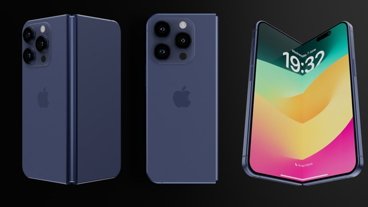Apple's rumored iPhone 18 Pro camera update has surfaced again, with the use of a variable aperture wide-angle lens expected to offer improved depth of field effects in photography.
The iPhone 17 was rumored in July to gain a variable aperture system, which can change the way photographers use an iPhone for shooting images. Now, an analyst has doubled down on his own claim that it is a feature expected for the iPhone 18 Pro.
In a Monday post by TF Securities analyst Ming-Chi Kuo covering multiple Apple rumors, Kuo slips in a small element about the iPhone 18 Pro. It is declared that the iPhone 18 Pro's wide camera will be upgraded to use a variable aperture in 2026.
The reason for the reference is because the article discusses BE Semiconductor, a supplier of assembly equipment. Some hardware it supplies is used to make aperture blades, a key part to enable a variable aperture in an iPhone camera module.
This is not the first time Kuo has talked about variable apertures in the iPhone 18 generation. A November posting by Kuo was based on his own industry sources, with the aperture able to "significantly improve the user's photography experience."
Variable aperture's benefits
Current smartphone photography relies on a fixed aperture, namely a defined size of hole for light to pass through between the lenses and the sensor. In an iPhone, the aperture is fixed, simply because using aperture blades to resize the hole and actuators to move those blades can take up valuable space.
A variable aperture system can make the aperture bigger and smaller, which affects the amount of light hitting the sensor. This can force other parts of the exposure triangle to change, such as increasing the amount of time it takes for the shot to be actually taken, so that enough light is captured.
The result of changing the size of the aperture is the ability to change the visible depth of field. By making the aperture larger, that could force the depth of field effect to be narrower, introducing the blurry bokeh in the background behind the subject.
Current iPhone photographers will be aware of the Portrait Mode's depth of field adjustment system, which does so computationally. It takes a sharp image, detects the subject, then simulates bokeh blur in the background elements to fake the effect.
With a variable aperture, users who want the real thing can actually get it without any post-processing assistance.
 Malcolm Owen
Malcolm Owen







-m.jpg)






 Bon Adamson
Bon Adamson
 Marko Zivkovic
Marko Zivkovic
 Amber Neely
Amber Neely



 Christine McKee
Christine McKee



-m.jpg)






28 Comments
What a complete and total miscue. You would think from Apple's focus on camera, camera, camera that we buy iPhones to become professional photographers. If we were professional photographers we would spend thousands on pro cameras like Leica and not buy a phone.
Instead of Apple reminding itself that the reason people buy phones is to make phone calls and send text messages. The phone call quality is good in most cases. The texting is horrible, horrible, horrible.
It is nigh impossible to write a text message without making some stupid, embarrassing mistake and when you attempt to go back and fix it you get stepped over by that dumb auto-correct. So say you are trying to type luv you. You get lettuce. How dumb is that?
But hey, camera, camera, camera we are all wanting to become professional photographers and movie directors.
Without the great visionary Steve Jobs Apple has lost its way and is eating the fruits of the tree that he created.
Ironically I was watching a demo that Steve did years ago, prophetic words: 'we don't create the technology and then try to find the market, but the other way around, we find out what people want and then create the best tech we can'.
Words to live by. Recently I read an article on this forum that the site where Steve Jobs demoed the first Mac has been turned into rubble. May I add that his great vision and mission statement for Apple has also been razed in the interest of $$$.
Great example, the Vision Pro. Nobody in their right mind wanted or asked for that. So Apple spent billions creating a device that no one wants or asked for and now they are trying to shoe horn it into the market. Precisely the opposite of what Steve said all those years ago.